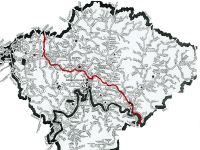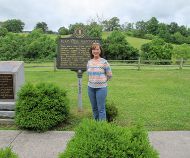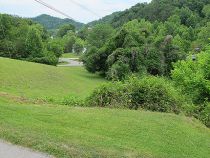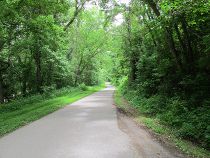Imagine stepping into a time machine and whirling back to the year 1775.
Suddenly, you are walking alongside the frontiersman Daniel Boone and his party of 30 axmen. They are marking a trail for other settlers to follow into the wilderness – a trail that will eventually cover a distance of 120 miles from Cumberland Gap to Fort Boonesborough.
That trail will be known as the Boone Trace and used by thousands of early settlers.
Now, as it turns out, the above scenario is not as far-fetched as it seems.
Thanks to a joint effort between the Barbourville Tourism Commission and the Knox Historical Museum History Center, those interested in history will soon be driving, even walking in some cases, on well-marked portions of the exact route of the Boone Trace in Knox County, Kentucky.
"There is a real effort being made to identify the Boone Trace all the way from the Gap to Boonesborough," said Knox Historical Museum President Michael C. Mills. "Now out of all the counties that are researching the Trace in their county, we're the first to actually map it and put signage on it. That's what we're doing right now. The museum staff is out putting Boone Trace signs on the original Boone Trace."
Mills and other members of the are also planning to give guided tours of portions of the Trace, including both walking and driving tours, and hoping to educate the public about the importance of the route. Members participating include Steve Valentine, Doug Bargo, Charles Mitchell, David Cole, and Carla Lawson.
"It's especially exciting to us to show the people who actually live on the Trace, and don't even know it, that they live right on a historic route like that," Mills said.
The Boone Trace is considered by Mills and many statewide and national historians to be a fundamental pioneer route through southeastern Kentucky, far more significant as a ground-breaking road into the state than the later Wilderness Road.
"The Boone Trace was the first road through southeast Kentucky, not counting the Warriors' Path and Skaggs Trace," Mills said. "The Boone Trace preceded the Wilderness Road by 21 years. 1775 was the Trace. In 1796, when they awarded the contract for the Wilderness Road, they tried to make it a wagon road and that caused it to have to be changed quite a bit.
"They had to come down to the lower grades so they could pull a wagon. When they were doing the trace, they didn't mind going up and over a hill to shorten the distance, but when it came to pulling a wagon, that changed it almost completely. They were totally two different roads. They were never just the same road widened."
{imageshow sl=11 sc=3 /}
According to Mills, the Trace passes through the center of Knox County, basically from south to northeast of U.S. 25E. It enters southern Knox County to the northeast of U.S. 25E and the Cumberland River and passes the mouths of Ely Branch and then Pogue Hollow. At the northern side of Knox County, the Trace passes into Laurel County off KY 830.
Several portions of the Trace in Knox County are truly evocative, said Mills, noting, "If you enter what we call the Ely Hollow-Pogue Hollow loop, which is before you get to Flat Lick when you're just coming into Knox County, you can loop over there on what was later the route of the old Dixie Highway.
"There's not a house on it after you start through this loop. You've got the river on your left side, the railroad on the other side, and you're right on the path. It is picturesque. You'll feel like Daniel Boone could be there today. There's no sign of life. You can follow that loop into the county and you come out at the entrance to south Flat Lick where the little underpass is."
Maps and more information about the above-mentioned drive and the complete route of the Boone Trace through Knox County are listed on the Knox Historical Museum's new website. That address is "knoxhistoricalmuseum.org." The website features detailed maps and driving directions.
Mills noted that some parts of the Trace essentially run along or near existing roads in each community the Trace goes through, but there are also areas that go up and over ridges that are on private property.
"But we've made arrangements in the Bimble area with some local residents to actually leave U.S. 25 and go up to an original piece of the old trail."
Knox County's project is part of a larger project that involves two regional organizations that are helping coordinate and support the project. One is the Boone Trace Society, headed by Sam Compton, based in Hendersonville, Tenn. The other is the Friends of Boone Trace, headed by John Fox, based in Madison County, Ky. Another resource is Tom N. Shattuck of Middlesboro, who for years has given tours of the Wilderness Road. Shattuck has done considerable research and produced maps identifying the route. He authored the Cumberland Gap Area Guidebook, which includes maps and information on the history of the area.
Mills said Compton supplied the museum with the Boone Trace maps for Knox County that were prepared by Neil O. Hammon, who is the author of several books about Boone and Kentucky's frontier.
"The maps coincide very closely with our maps," Mills noted. "We were pleased to death to compare them with our research at the museum. When we did a close study between the maps we got from Sam Compton and the maps that had been left by our previous historians, such as Erwin Bradley at Union College, Sherman Oxendine, Sol Warren, Elmer Decker, and others, it was pretty much right on line."
Mills said John Fox has given positive feedback on the signage used in Knox County. "He called me last week and said he would like to see the same color and signs used all the way from Cumberland Gap to Boonesborough. Bell County is using the same sign maker as us and is going with the same sign, so that's a good start."
Another enthusiastic local supporter of the Boone Trace is Barbourville Tourism Director Denise Wainscot, whose organization provided signage for the Knox County project and has pledged additional support for items, such as brochures.
"We feel this is a premier project to be involved in," Wainscot said. "This will help attract visitors to our region, especially those who are interested in history and genealogy. It's a great project."




